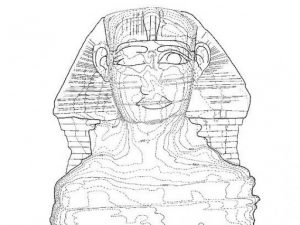Jonathan Shaw in Harvard Magazine:
 The pyramids and the Great Sphinx rise inexplicably from the desert at Giza, relics of a vanished culture. They dwarf the approaching sprawl of modern Cairo, a city of 16 million. The largest pyramid, built for the Pharaoh Khufu around 2530 B.C. and intended to last an eternity, was until early in the twentieth century the biggest building on the planet. To raise it, laborers moved into position six and a half million tons of stone—some in blocks as large as nine tons—with nothing but wood and rope. During the last 4,500 years, the pyramids have drawn every kind of admiration and interest, ranging in ancient times from religious worship to grave robbery, and, in the modern era, from New-Age claims for healing “pyramid power” to pseudoscientific searches by “fantastic archaeologists” seeking hidden chambers or signs of alien visitations to Earth. As feats of engineering or testaments to the decades-long labor of tens of thousands, they have awed even the most sober observers.
The pyramids and the Great Sphinx rise inexplicably from the desert at Giza, relics of a vanished culture. They dwarf the approaching sprawl of modern Cairo, a city of 16 million. The largest pyramid, built for the Pharaoh Khufu around 2530 B.C. and intended to last an eternity, was until early in the twentieth century the biggest building on the planet. To raise it, laborers moved into position six and a half million tons of stone—some in blocks as large as nine tons—with nothing but wood and rope. During the last 4,500 years, the pyramids have drawn every kind of admiration and interest, ranging in ancient times from religious worship to grave robbery, and, in the modern era, from New-Age claims for healing “pyramid power” to pseudoscientific searches by “fantastic archaeologists” seeking hidden chambers or signs of alien visitations to Earth. As feats of engineering or testaments to the decades-long labor of tens of thousands, they have awed even the most sober observers.
The question of who labored to build them, and why, has long been part of their fascination. Rooted firmly in the popular imagination is the idea that the pyramids were built by slaves serving a merciless pharaoh. This notion of a vast slave class in Egypt originated in Judeo-Christian tradition and has been popularized by Hollywood productions like Cecil B. De Mille’s The Ten Commandments, in which a captive people labor in the scorching sun beneath the whips of pharaoh’s overseers. But graffiti from inside the Giza monuments themselves have long suggested something very different.
More here.
